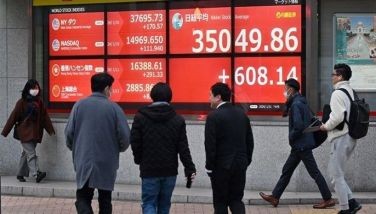February inflation lowest in 2 years
March 6, 2002 | 12:00am
The country’s inflation rate eased to its lowest level in two years at 3.4 percent in February, declining further from the previous month’s 3.8 percent, the National Statistics Office (NSO) reported yesterday.
The government statistics office said the latest figure was better than the government’s projection of 3.9 percent.
Bangko Sentral ng Pilipinas (BSP) Governor Rafael B. Buenaventura said the decline in annual inflation gives the BSP further flexibility in considering another reduction in overnight interest rates.
"It’s a very pleasant surprise... and gives us more flexibility (in rates setting)," Buenaventura said.
However, he added the BSP would have to review the number as well as inflationary expectations for the full year in considering its next move in interest rates.
The government expects the 2002 inflation rate to range between 4.5 percent to 5.5 percent.
According to the NSO report, price increases in all the commodity groups that make up the consumer price index basket slowed last month except for clothing.
Compared to January, there was a "significant reduction in the prices of food, particularly rice, fish, fruits, vegetables and meat," the NSO said.
A drop in prices of liquefied petroleum gas and kerosene, both used as fuel for cooking, along with lower electricity consumption in the National Capital Region (NCR) also contributed to the downtrend.
By area, inflation in the NCR declined to 4.6 percent in February from 5.2 percent in January due mainly to the downward movements in the rates of housing and repairs, fuel, light and water (FLW), services and miscellaneous items.
In Areas Outside Metro Manila, inflation also slid to 2.8 percent in February from 3.2 percent as prices of all commodity groups grew at a slower rate.
Among the regions, the biggest price decrease was recorded in Southern Tagalog followed by Bicol and Western Visayas.
The lowest inflation rate was still recorded in Cagayan Valley at 0.8 percent while the highest rate at 4.9 percent was noted in Eastern Visayas.
The government statistics office said the latest figure was better than the government’s projection of 3.9 percent.
Bangko Sentral ng Pilipinas (BSP) Governor Rafael B. Buenaventura said the decline in annual inflation gives the BSP further flexibility in considering another reduction in overnight interest rates.
"It’s a very pleasant surprise... and gives us more flexibility (in rates setting)," Buenaventura said.
However, he added the BSP would have to review the number as well as inflationary expectations for the full year in considering its next move in interest rates.
The government expects the 2002 inflation rate to range between 4.5 percent to 5.5 percent.
According to the NSO report, price increases in all the commodity groups that make up the consumer price index basket slowed last month except for clothing.
Compared to January, there was a "significant reduction in the prices of food, particularly rice, fish, fruits, vegetables and meat," the NSO said.
A drop in prices of liquefied petroleum gas and kerosene, both used as fuel for cooking, along with lower electricity consumption in the National Capital Region (NCR) also contributed to the downtrend.
By area, inflation in the NCR declined to 4.6 percent in February from 5.2 percent in January due mainly to the downward movements in the rates of housing and repairs, fuel, light and water (FLW), services and miscellaneous items.
In Areas Outside Metro Manila, inflation also slid to 2.8 percent in February from 3.2 percent as prices of all commodity groups grew at a slower rate.
Among the regions, the biggest price decrease was recorded in Southern Tagalog followed by Bicol and Western Visayas.
The lowest inflation rate was still recorded in Cagayan Valley at 0.8 percent while the highest rate at 4.9 percent was noted in Eastern Visayas.
BrandSpace Articles
<
>
- Latest
- Trending
Trending
Latest
Latest
Recommended






























